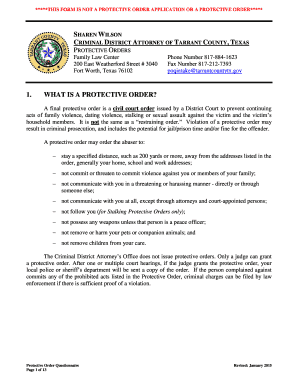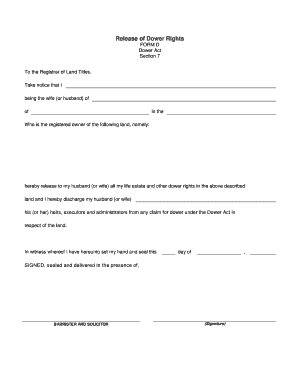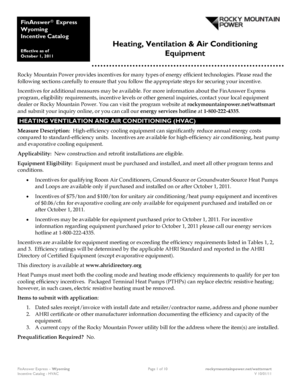
Get the free texas attorney protective order form
Show details
Notary Public in and for the State of Texas My Commission expires Check one or both the Court to order the Respondent to pay support in an amount set by the Court. And the Applicant asks for these Orders in the best interest of the people named on page 1 of this form. Look at the top of your Order and copy the same information here. Order is check one Attached or Not available now but will be filed before the hearing on this Application. Sample Only Do Not File Form Approved by the Supreme...
pdfFiller is not affiliated with any government organization
Get, Create, Make and Sign

Edit your texas attorney protective order form online
Type text, complete fillable fields, insert images, highlight or blackout data for discretion, add comments, and more.

Add your legally-binding signature
Draw or type your signature, upload a signature image, or capture it with your digital camera.

Share your form instantly
Email, fax, or share your texas attorney protective order form via URL. You can also download, print, or export forms to your preferred cloud storage service.
How to edit texas attorney protective order online
Use the instructions below to start using our professional PDF editor:
1
Register the account. Begin by clicking Start Free Trial and create a profile if you are a new user.
2
Prepare a file. Use the Add New button. Then upload your file to the system from your device, importing it from internal mail, the cloud, or by adding its URL.
3
Edit protective order kit form. Add and change text, add new objects, move pages, add watermarks and page numbers, and more. Then click Done when you're done editing and go to the Documents tab to merge or split the file. If you want to lock or unlock the file, click the lock or unlock button.
4
Get your file. Select your file from the documents list and pick your export method. You may save it as a PDF, email it, or upload it to the cloud.
pdfFiller makes working with documents easier than you could ever imagine. Register for an account and see for yourself!
How to fill out texas attorney protective order

How to fill out protective orders:
01
Obtain a blank copy of the protective order form from the appropriate courthouse or online source.
02
Carefully read the instructions provided with the form to understand the requirements and guidelines for filling it out.
03
Fill in the necessary personal information, such as your name, address, and contact details.
04
Specify the type of protective order you are seeking, whether it is for domestic violence, stalking, or another specific reason.
05
Clearly describe the incidents and reasons why you are seeking a protective order, providing as much detail as possible.
06
If applicable, include any supporting evidence or documents, such as police reports, medical records, or witness statements, to strengthen your case.
07
Sign and date the completed protective order form.
08
Make copies of the form for your personal records and keep them in a safe place.
09
File the completed form with the appropriate courthouse or law enforcement agency as instructed in the provided guidelines.
10
Follow up with the court or agency to ensure that your protective order request is processed and reviewed.
Who needs protective orders:
01
Individuals who have experienced domestic violence or abuse from their current or former partners may need protective orders.
02
People who have been victims of stalking or harassment from someone and fear for their safety may require protective orders.
03
Vulnerable individuals who have been subjected to elder abuse or exploitation may benefit from obtaining protective orders for their protection.
04
Those who have been threatened, physically assaulted, or fear for their safety due to any other reasons may also consider seeking protective orders.
05
It is important to consult with legal professionals or domestic violence support organizations to assess if a protective order is necessary in your specific situation.
Fill texas general protective : Try Risk Free
People Also Ask about texas attorney protective order
What do you need to get a protective order in Virginia?
What is a protective order in VA?
What is a protective order in Indiana?
Is there a difference between a restraining order and a protective order in Indiana?
How does an Indiana protective order work?
How much is a protective order in Indiana?
Our user reviews speak for themselves
Read more or give pdfFiller a try to experience the benefits for yourself
For pdfFiller’s FAQs
Below is a list of the most common customer questions. If you can’t find an answer to your question, please don’t hesitate to reach out to us.
How to fill out protective orders?
1. Obtain the appropriate form. The form will vary depending on the jurisdiction, so you should contact your local courthouse or law enforcement agency for the specific form you need.
2. Provide the necessary information. This will usually include the name and contact information for both parties, as well as the reason for the order.
3. List the terms of the order. These could include a restraining order, stay away order, or any other terms to which both parties must abide.
4. Sign and submit the form. Once you’ve filled out the form, both parties must sign and submit it to the court or law enforcement agency.
5. Follow up. Depending on the jurisdiction, you may need to follow up with the court or law enforcement agency to ensure the order is being enforced.
What is protective orders?
A protective order is a legal document issued by a court to protect a person from potential harm or harassment. It is typically granted in cases involving domestic violence, harassment, stalking, or other forms of abuse. The order may require the person causing harm to stay away from the person seeking protection, refrain from contacting or communicating with them, and may establish other specific provisions to ensure the safety of the person. Violating a protective order can lead to legal consequences such as fines or even imprisonment.
Who is required to file protective orders?
Protective orders are typically filed by individuals who believe they are at risk of harm or harassment from another person. These orders aim to provide legal protection and prevent contact or proximity between the two parties, ensuring the safety of the person seeking the order. The specific requirements for filing protective orders may vary based on jurisdiction and the nature of the relationship between the parties involved. It is recommended to consult with a legal professional or local authorities for accurate information regarding protective orders in a specific jurisdiction.
What is the purpose of protective orders?
The purpose of protective orders, also known as restraining orders or domestic violence orders, is to protect individuals who have experienced or are at risk of experiencing abuse, harassment, stalking, or violence. These orders are legal documents issued by a court that require a specific person to refrain from certain actions or to stay away from the protected party. The purpose of protective orders is to provide immediate and legal protection to victims, preventing contact or further harm from the person causing the abuse. Protective orders aim to ensure the safety, security, and well-being of those seeking protection, offering a legal recourse and providing a sense of security and peace of mind.
What information must be reported on protective orders?
The specific information that must be reported on protective orders can vary depending on the jurisdiction, but generally, the following information is typically included:
1. Full names and contact information of the parties involved: This includes the names, addresses, and telephone numbers of the person requesting the protective order (plaintiff) and the person against whom the order is sought (defendant).
2. Relationship between the parties: The nature of the relationship between the plaintiff and defendant is usually required. This might include information on whether they are spouses, former spouses, family members, current or former partners, or individuals with a child in common.
3. Specific incidents or acts of harm: The reported protective order generally requires the plaintiff to provide details about the specific incidents or acts of harm that have occurred, including dates, times, and locations.
4. Types of prohibited conduct: The order should specify the types of behavior that are prohibited in order to protect the plaintiff. This may include physical violence, threats, harassment, stalking, or any other relevant conduct.
5. Duration and conditions of the order: The protective order should specify how long it will be in effect and any specific conditions or restrictions imposed on the defendant. This might include orders to stay away from the plaintiff, surrender firearms, attend counseling, or cease communication.
6. Notice of consequences: The protective order should clearly outline the consequences for violating its terms. This could include potential criminal charges, fines, or other penalties.
It is important to note that these requirements can vary depending on the legal jurisdiction. It is advisable to consult the specific laws and regulations of the relevant jurisdiction for accurate and up-to-date information.
What is the penalty for the late filing of protective orders?
The penalty for late filing of protective orders can vary depending on the jurisdiction and the specific circumstances of the case. However, common penalties may include:
1. Rejection of the late filing: In some cases, the court may simply reject the late-filed protective order, leaving the petitioner without the requested protection.
2. Delay in obtaining protection: If the protective order is accepted despite being filed late, the petitioner may experience a delay in obtaining the desired protection. This delay can result in potential harm or continued harassment.
3. Contempt of court: In certain instances, the court may hold the party responsible for the late filing in contempt. This can result in fines, additional legal fees, or other punitive measures.
4. Loss of legal standing: Failing to timely file a protective order may cause the court to question the seriousness of the petitioner's request, potentially resulting in diminished credibility or legal standing.
It is essential to consult with a legal professional to understand the specific penalties and consequences in your jurisdiction.
How can I modify texas attorney protective order without leaving Google Drive?
Simplify your document workflows and create fillable forms right in Google Drive by integrating pdfFiller with Google Docs. The integration will allow you to create, modify, and eSign documents, including protective order kit form, without leaving Google Drive. Add pdfFiller’s functionalities to Google Drive and manage your paperwork more efficiently on any internet-connected device.
How can I send texas protective order form for eSignature?
When you're ready to share your texas protective order form pdf, you can swiftly email it to others and receive the eSigned document back. You may send your PDF through email, fax, text message, or USPS mail, or you can notarize it online. All of this may be done without ever leaving your account.
How do I execute order protective online?
pdfFiller has made filling out and eSigning protective orders form easy. The solution is equipped with a set of features that enable you to edit and rearrange PDF content, add fillable fields, and eSign the document. Start a free trial to explore all the capabilities of pdfFiller, the ultimate document editing solution.
Fill out your texas attorney protective order online with pdfFiller!
pdfFiller is an end-to-end solution for managing, creating, and editing documents and forms in the cloud. Save time and hassle by preparing your tax forms online.

Texas Protective Order Form is not the form you're looking for?Search for another form here.
Keywords relevant to texas restraining order form
Related to texas division order form
If you believe that this page should be taken down, please follow our DMCA take down process
here
.
























